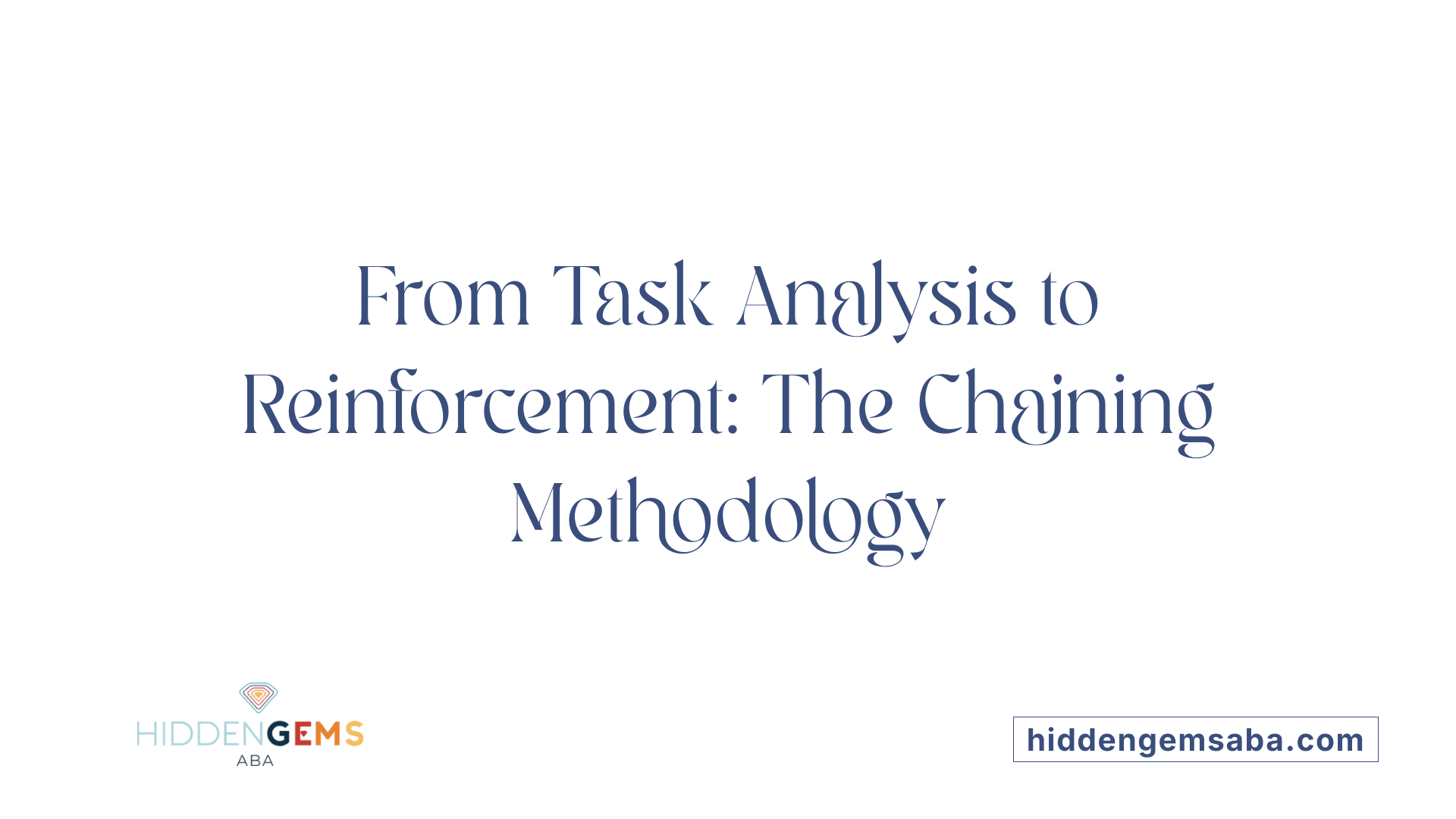Understanding Chaining Techniques in ABA Therapy
Applied Behavior Analysis (ABA) is a widely respected, evidence-based approach used to teach new skills and modify behaviors, particularly for individuals with autism. One of its core strategies is 'chaining,' a technique designed to teach complex, multi-step tasks by breaking them down into manageable parts. This article explores the various chaining methods, how they function, and their impact on learning and behavior modification.
What Are the Main Types of Chaining Techniques Used in ABA Therapy?

What are the main types of chaining techniques used in ABA therapy?
In ABA therapy, the approach to teaching complex skills often involves breaking down tasks into smaller, manageable steps, a process known as chaining. There are three primary methods used to implement chaining, each suited to different learning styles and task complexities.
First is forward chaining. This method begins by teaching the first step of a task. Once the learner masters this initial step, the next step is introduced, and so on. The focus is on progressing sequentially from start to finish. This method helps learners build confidence early by mastering initial steps and gradually moving through the entire task.
Next, backward chaining teaches the last step of the task first. After the learner becomes proficient at completing the final step, the process works backward to the preceding steps. This approach is motivating because it allows the learner to experience success and reach the goal more quickly, which can boost confidence.
The third method is total task chaining. Here, all steps of a task are taught simultaneously within a session. The learner practices the entire sequence with prompts and supports as needed. Over time, prompts are faded, and independence is encouraged. This method gives the learner an overall understanding of the entire skill early on, promoting quicker generalization.
Choosing the appropriate chaining method depends on the specific skill being taught, the learner’s current abilities, and the context. Therapists carefully select the most suitable technique to maximize learning success, whether that involves starting from the beginning, the end, or the entire task at once. These strategies enable individuals with autism to acquire new skills efficiently, paving the way for greater independence in daily life.
The Process of Behavior Chaining in ABA Therapy

What is the process of behavior chaining in ABA therapy?
Behavior chaining in Applied Behavior Analysis (ABA) therapy is a structured teaching approach used to help individuals learn complex skills by breaking them down into smaller, manageable components. This method involves several steps that ensure effective skill acquisition and independence.
First, the process begins with conducting a thorough task analysis. This involves observing the target behavior and identifying each step necessary to complete the task. These steps are written out clearly to serve as the foundation for teaching.
Next, therapists or caregivers choose an appropriate chaining method—such as forward, backward, or total task chaining—based on the individual’s needs and the nature of the task.
The next phase involves teaching each step systematically. Starting with the first step in forward chaining, the individual is prompted and reinforced for completing that step successfully. As each step is learned, new steps are gradually added, reinforcing the sequence until the entire activity can be completed.
Prompting and reinforcement play crucial roles throughout this process. Prompts may range from visual cues to physical guidance, with the level of assistance gradually faded as the individual becomes more independent. Reinforcers, such as praise or preferred items, motivate the learner and strengthen each successful behavior.
Finally, progress is continuously monitored. Therapists observe how well the individual performs the chain, adjust prompts as needed, and celebrate mastery of each step. This ongoing assessment helps tailor the teaching process to maximize learning outcomes.
Overall, behavior chaining in ABA is a step-by-step approach that builds confidence and competence, helping individuals acquire skills necessary for daily life, communication, and independence.
Variations and Applications of Chaining Techniques
Chaining techniques are versatile methods used in ABA therapy to teach complex behaviors by linking smaller, manageable steps. Understanding how different types of chaining apply in various contexts allows therapists to tailor interventions to each child's needs.
One primary application of chaining is in developing essential self-care skills. For example, teaching a child to brush their teeth often involves breaking down the process into steps like picking up the toothbrush, applying toothpaste, brushing, rinsing, and drying. Using total task chaining, therapists teach all these steps within a session, gradually fading prompts as independence grows. Alternatively, backward chaining can be used where the child is first taught to rinse and dry, sparking confidence, then gradually learning the previous steps.
In developing communication and social skills, chaining can help children learn to initiate interactions, respond appropriately, or follow social routines. For instance, a child learning to greet a peer might have steps such as approaching, making eye contact, saying hello, and waiting for a response. Forward chaining can be effective here—first mastering approaching and greeting, then progressively adding more complex social behaviors.
Academic skills benefit greatly from chaining techniques as well. Tasks such as solving math problems, reading comprehension, or writing involve multiple steps. For example, teaching a student to write an essay involves planning, drafting, revising, and editing. Total task chaining can be employed in small units of these tasks to reinforce understanding of the entire process simultaneously.
How do different types of chaining techniques vary in application?
Different chaining methods are selected based on individual abilities, task complexity, and learning goals. Forward chaining begins by teaching the initial step and adding successive steps, optimal when learners need to master the beginning of a sequence first. Backward chaining starts by focusing on the last step, which can motivate learners because completing the final step offers immediate reinforcement and a sense of achievement. Total task chaining involves teaching all steps at once, ideal when the overall task is well-structured and the learner can handle multiple steps with support.
Choosing the appropriate method depends on the child's current skills, the nature of the behavior targeted, and the specific outcome desired. A combination of these techniques can often be used to maximize learning and independence.
Further insights
For more on the topic, searching
Differences Between Chaining and Other ABA Techniques
Chaining and shaping are both fundamental techniques in applied behavior analysis (ABA), but they serve different purposes and operate in distinct ways.
Comparison with shaping
Chaining is primarily focused on teaching a sequence of connected behaviors that form a complete task. For example, if a child is learning to brush their teeth, chaining would involve breaking down the entire task into smaller, manageable steps—like picking up the toothbrush, applying toothpaste, brushing, rinsing, and putting away the toothbrush. Each step is systematically taught and reinforced, often progressing in a specific order such as forward or backward chaining.
Shaping, however, is used to develop entirely new behaviors that the individual does not yet perform. It works by reinforcing successive approximations of a behavior; that is, encouraging the individual to gradually get closer to the desired behavior. For instance, if a child cannot say the word "juice," a therapist might reinforce the sound "ju," then "jui," and finally "juice" as their speech improves.
While chaining explicitly links multiple steps into a comprehensive skill, shaping is about raising the complexity of a single behavior step-by-step. Both rely on reinforcement but focus on different behavioral goals.
Unique functions of chaining
Chaining's unique role is to enable individuals to perform complex, multi-step tasks independently. It’s especially useful for routines like dressing, handwashing, or academic tasks such as solving a math problem in steps. The process involves detailed task analysis—breaking down the task into small behaviors—and then teaching each part in sequence.
The different types of chaining—forward, backward, and total task—allow therapists to tailor the learning experience to the individual’s needs and the nature of the task. For example, backward chaining can motivate learners by starting with the last step, which often provides immediate reinforcement.
In contrast, shaping is more suited for skill acquisition where the behavior itself is new or involves complex behaviors that are not sequential. It helps in developing speech, social behaviors, or other novel actions by reinforcing small steps towards the full behavior.
Both techniques can be combined effectively in ABA to maximize learning. While chaining helps organize and teach multi-step tasks, shaping can be used to foster new behaviors that are then integrated into these chains.
Summary Table of Differences
| Aspect | Chaining | Shaping |
|---|---|---|
| Purpose | Teach multi-step tasks | Develop new behaviors via approximation |
| Focus | Linking behaviors in sequence | Reinforcing small steps or sounds |
| Application | routines like dressing, teeth brushing | speech development, social behaviors |
| Method | Task analysis, sequential teaching | Successive approximation, reinforcement |
| Flexibility | Offers different types (forward, backward, total) | Highly flexible for new behavior creation |
| Complementarity | Often combined in intervention strategies | Often used before or alongside chaining |
Understanding these differences helps in selecting the right approach for each learner, ensuring targeted and effective skill development in ABA programs.
Enhancing Learning Through Chaining in ABA Therapy
 Chaining is a proven instructional method used in Applied Behavior Analysis (ABA) therapy to help individuals, especially children with autism, learn complex skills by breaking them into small, manageable steps. This approach makes learning more accessible and less overwhelming.
Chaining is a proven instructional method used in Applied Behavior Analysis (ABA) therapy to help individuals, especially children with autism, learn complex skills by breaking them into small, manageable steps. This approach makes learning more accessible and less overwhelming.
One of the major benefits of chaining is increased student engagement. When tasks are divided into clear, sequential steps, learners tend to be more focused and motivated, as each small success encourages them to continue. This structured process also helps reduce feelings of frustration or anxiety, making therapy sessions more positive and productive.
Chaining techniques such as forward chaining, backward chaining, and total task chaining are tailored to meet individual needs. For example, backward chaining starts teaching from the last step, giving learners a sense of accomplishment early on. Total task chaining involves practicing all steps together, gradually reducing prompts to foster independence.
By reinforcing each step through positive feedback, chaining not only teaches skills but also promotes confidence. Over time, students develop greater independence, confidently performing routine tasks like brushing teeth or dressing without continuous guidance. This progression ultimately supports their ability to navigate daily life with increasing ease.
| Chaining Method | Approach | Best For | Effect on Independence |
|---|---|---|---|
| Forward Chaining | Teach starting from the first step, adding more later | Tasks where starting cues are manageable | Builds confidence gradually |
| Backward Chaining | Teach from the last step, working backwards | Tasks where ending is motivating | Boosts motivation and sense of completion |
| Total Task Chaining | Teach entire task at once with prompts as needed | Complex tasks requiring comprehensive understanding | Encourages overall independence |
In summary, chaining is an effective strategy that supports skill development by making learning more engaging, less stressful, and fostering independence. This approach underpins many successful ABA interventions, helping individuals acquire crucial daily living skills and improve their quality of life.
Conclusion: The Significance of Chaining in Behavior Modification
Chaining is a vital technique in ABA used to help individuals, especially those with autism, develop essential daily skills through breaking tasks into manageable steps. This approach not only enhances learning success but also promotes independence and confidence.
Different chaining methods, such as forward, backward, and total task chaining, provide flexible options tailored to each learner's needs. Therapists select the most suitable method based on the complexity of the task and the individual’s current skills. By doing so, they ensure that learning is efficient, motivating, and accessible.
Ultimately, chaining supports meaningful behavior change. It simplifies complex activities, making them easier to learn and retain. This technique's effectiveness relies on careful planning, consistent reinforcement, and personalized adjustment to each learner, making it a cornerstone of evidence-based behavior modification strategies.
Summary of Chaining's Role in ABA
Chaining remains a cornerstone of ABA therapy, serving as an effective method to break down complex behaviors into manageable steps, thereby improving skill acquisition and independence. By selecting the appropriate chaining technique—whether forward, backward, or total task—therapists can tailor interventions to meet individual needs, fostering confidence and functional skills in those with autism. Understanding and applying these techniques thoughtfully ensures that learners not only acquire new behaviors but also experience increased motivation and reduced anxiety, making ABA a powerful tool for meaningful, lasting change.
References
- Chaining | Nebraska Autism Spectrum Disorders Network
- Behavior Chaining - Applied Behavior Analysis Degrees
- Chaining In ABA Therapy | Circle Care Services
- Chaining in ABA Therapy: 5 Steps to Master Behaviors
- What Are the Three Types of Chaining in ABA? | Inclusive ABA
- What is Chaining in ABA Therapy? | Childwise
- Understanding Shaping and Chaining in ABA Therapy
- What is The Chaining Technique in ABA Therapy? - Brightside ABA
- What is Chaining in ABA Therapy? Benefits and Examples






